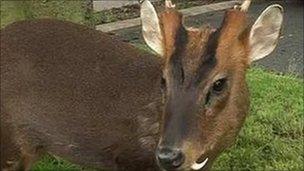Sanquhar muntjac deer 'shoot on sight' appeal issued
- Published

SNH describes the muntjac deer as "among the most destructive animal pests in Britain"
Scottish Natural Heritage has issued deer managers with a "shoot on sight" call after muntjac deer were reported in Dumfries and Galloway.
The non-native species was spotted in private forestry land near Sanquhar.
Night-vision binoculars have been used to try to confirm the sighting by an "experienced deer manager".
SNH has estimated that if a muntjac population became established in Scotland it could cost up to £2m-a-year to manage.
Muntjac deer have spread rapidly across England and Wales over the past 40 years and caused "extensive crop damage and road safety problems".
The small deer, which are originally from China, are now expanding northward, but so far they have not become established in Scotland.
SNH staff have been monitoring the area of the latest sightings for the past month, but so far no further sightings have been made.
Stan Whitaker, SNH advisor on non-native species, said: "Muntjac deer are among the most destructive animal pests in Britain.
"They damage young trees and coppiced woodland and, where they are in high numbers, they can cause damage to cereal crops and orchards.
"They pose a particular threat to our native oak woodlands and bluebells."
The organisation's wildlife management officer for south Scotland, Jamie Hammond, said it had to take all muntjac reports seriously.
"Most of the time they turn out to be false alarms, but in this instance the report was from a reliable source," he said.
"We have contacted all the neighbouring land owners and urged deer managers in the local area to remain vigilant and shoot any muntjac deer on sight if they get the opportunity."
'Mixed messages'
However, Alex Hogg, chairman of the Scottish Gamekeepers Association, warned that might not be enough to stop their advance.
"People can take a shoot on sight policy but it may not actually stop the deer from coming," he said.
"For example, we have had Japanese Sika deer in Scotland now for 100 years."
He said it was all about "balance".
"If there are too many, they will cause damage," he said.
"If managed properly, this doesn't need to be the case."
He added that the "shoot on sight" policy was not being applied uniformly for non-native species.
"For example, no such decisive action was taken regarding beavers and we suspect this is because the authorities felt the public would be up in arms," he said.
"There seems to be selective, mixed messages being sent our regarding non-native species."
- Published6 October 2011
- Published23 February 2011